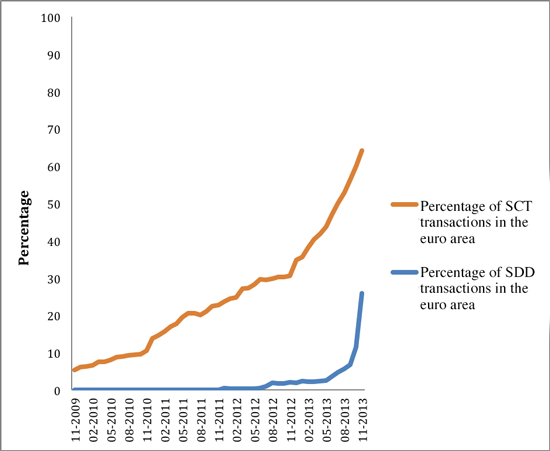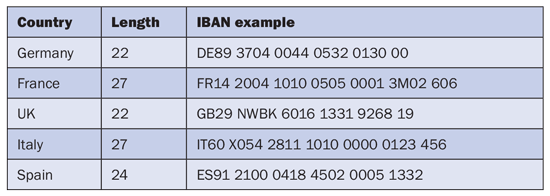Become familiar with the current implementation status of the Single Euro Payments Area (SEPA) and the reasons for the suggested postponement of the regulation. Understand the main consequences of SEPA for companies doing business in Europe. Get an overview of the most important SEPA functions delivered within the SAP Financials system. Learn critical elements and best practices of a SEPA implementation project.
Key Concept
The
Single Euro Payments Area (SEPA) enables citizens, companies, and other stakeholders to make and receive payments in euros within Europe, whether across or within national boundaries, under the same basic conditions, rights, and obligations, regardless of their location. The political drivers behind SEPA are the
European Commission and the
European Central Bank. SEPA
is one of the largest projects in the history of pan-European monetary transactions. It is another major step toward a common financial market following the introduction of the euro in 1999.
The implementation of the Single Euro Payments Area (SEPA) is around the corner. The end date in the eurozone for the migration of domestic as well as intra-European credit transfers and direct debits in euros toward SEPA credit transfers (SCT) and SEPA direct debits (SDD) was set to be February 1, 2014.
Three weeks before this deadline, however, the European Commission proposed to amend the SEPA Regulation (EU) 260/2012 with a grandfathering clause that would allow banks and other payment service providers “to continue also after 1 February 2014, for a limited period of time of 6 months, the processing of non-compliant payments through their legacy payments schemes alongside SCT and SDD.” SEPA requires all corporations that are doing business in Europe to comply with new payment standards, to change master data, and to reconsider their business processes in financial accounting, cash, and treasury management. The proposal must be approved by the European Parliament and the Council of the European Union.
The Current Status of SEPA
In its proposal to postpone the implementation of SEPA for six months, the European Commission raised its concern about the “low migration pace in some member states for SCT and in most member states for SDD” and considered it to be “very unlikely” that the SEPA migration would be fully complete in February. This concern is valid given the slow adoption for the new payment instruments so far and the fact that conversion rates are lower than expected at the moment. According to the latest statistics of the European Central Bank (ECB), the overall SCT migration rate (the share of SCT transactions among all transactions processed) in the euro area more than doubled from 30.6 percent in November 2012 to 64.1 percent in November 2013. The overall SDD migration rate grew from 59.9 percent in October 2013 to 64.1 percent in November 2013. The overall migration rate for SEPA Direct Debits (SDD) increased from a very low level of 2 percent in November 2012 to 26 percent in November 2013 (Figure 1).

Figure 1
Current migration rates of SEPA credit transfers and direct debits in the euro area (source: ECB)
Although conversion rates are rising, they’re still rising more slowly than expected and are now, only weeks before the initially suggested deadline, still below where they should be at this time. The overall level of preparation looks even worse when breaking these numbers down to a country level. For example, Germany, the biggest economy in the eurozone, reported less than 1 percent of SDD and less than 15 percent of SCT adoption in the third quarter of 2013, according to the latest ECB statistics. The European Commission pointed out that mainly small and medium-sized enterprises (SMEs), small public administrations, and local authorities continue to be the least prepared for the actual migration. This lack of preparation could lead to serious issues if the SEPA deadline on February 1, 2014, isn’t postponed.
In its proposed amendment, the European Commission said it was afraid that banks and other payment service providers would refuse processing noncompliant SEPA payments. This could lead to delays in salary payments or other market disruptions affecting all payment services users, particularly SMEs and consumers.
With its proposal, the European Commission wants to make sure that banks and payment service providers continue to process payments, allowing them to use retail and corporate clients’ existing legacy (domestic) payment schemes such as BACS (Bankers’ Automated Clearing Services) in the UK alongside the new SEPA formats SCT and SDD. The amendment to the original SEPA regulation 260/2012 is positioned by the European Commission “as an exceptional measure,” and the commission stresses in its proposal that the delay is kept “as short as possible, as a rapid and comprehensive migration is necessary in order to achieve the full benefits from an integrated payments market.” The commission also wants to make sure that the costs for the payment service providers to maintain parallel payment infrastructures for another period of six months are limited. I expect the grandfathering clause will be put into effect.
The Scope of SEPA
SEPA applies to all national and cross-border euro payments within and between the 28 member states of the EU and the four EFTA (European Free Trade Association) countries: Iceland, Liechtenstein, Norway, and Switzerland. The objective of SEPA is to establish harmonized payment systems and procedures in these 32 countries. This means establishing European standards for processing payments, reducing barriers to market entry, increasing efficiency, and lowering transfer costs. SEPA applies to companies not only in Europe but also in the United States and other countries that have subsidiaries in Europe. So-called one-leg-out payments — i.e., either the payment service provider of the payer or beneficiary is not located within the SEPA — are not subject to SEPA regulations.
Besides the two new SEPA payment instruments, SCT and SDD, SEPA introduces the following additional changes:
- Usage of XML formats: Both SCT and SDD payments are based on ISO (International Organization for Standardization) 20022 payment processing standards and are defined as XML (Extensible Markup Language) formats. Both are defined by ISO as PAIN (Payment Initiation) messages. Many of the currently used domestic payment formats in the eurozone are based on flat-file structures.
- Migration of domestic bank account numbers: The new payment formats require the use of the International Bank Account Number (IBAN), a standard developed by the ISO and the ECBS (European Committee for Banking Standards). The IBAN can have up to 34 characters and is structured differently in the different SEPA member states because of the different length of domestic bank routing numbers or the position of the domestic account number and the control sum inside the IBAN (Table 1).

Table 1
IBAN structure for selected European countries
- Migration of domestic bank identifiers: The new payment formats also require the use of the Bank Identifier Code (BIC), which is often called Society for Worldwide Interbank Financial Telecommunication (SWIFT) code. This alphanumeric key is either eight or 11 characters long, and it allows businesses to identify all financial institutions that are connected to SWIFT. The SEPA regulation 260/2012 doesn’t require a BIC for domestic payments after 2014 and cross-border payments after 2016.
- New payment processes: SCT and SDD introduce new business processes for accounting, cash, and treasury managers. One of most significant changes is the introduction of a so-called mandate that is the authorization and expression of consent given by the debtor to the creditor allowing the collection of outstanding receivables from a specified debtor account. Creditors must store mandate information in their systems as proof of legitimate collections, as well as transfer mandate-related data to their financial institutions.
Figure 2 shows the impact SEPA has on corporations.

Figure 2
Impact of SEPA on corporations
SEPA Functions in the SAP System
SAP provides full SEPA functionality as part of the maintenance of the SAP system. Many functions are also available for the old SAP releases R/3 4.6C, R/3 Enterprise, and mySAP. However, some functions, such as the pre-notification for SEPA mandates, are only available for SAP ERP Central Component (SAP ECC) 6.0. SEPA functionality in the SAP system includes:
- Support of new IBAN and BIC master data, including integration with conversion services of domestic payment service providers
- Complete mandate management covering the entire life cycle of SEPA mandates
- Implementation of SCT and SDD with the Payment Medium Workbench and Data Medium Exchange Engine
- Support for import and processing of XML-based account statements (which is not mandatory as part of SEPA)
Many SEPA functions have been recently added or enhanced. Therefore, you need to carefully study the many support notes that are published on SAP’s support portal. This includes support for various SAP industry solutions or components such as SAP CRM.
Best Practices for a SEPA Project
To implement the necessary SEPA functions in an SAP system, SEPA project managers should first identify all areas within their organizations that are affected by SEPA. These will normally include:
- Sales and procurement (change of existing contracts, terms of trade, and forms)
- Finance department and cash management (changes to liquidity management and both incoming and outgoing payment processes)
- Accounting department (creation of IBAN and BIC master data in debtor and creditor master data, implementation of mandate management, and adaption of invoice forms)
- Human resource and legal department (collection of IBAN and BIC information for employees and legal compliance with the mandated life cycle)
- Marketing (change of external brochures)
The next step is to thoroughly analyze existing payment and cash-management practices, such as the number of e-banking applications, currently used payment methods, quality of master data, business volumes, and international networking within the group. Part of this exercise also should be an analysis of which bank connections are still needed in the SEPA.
Once this analysis is done, corporations can start to import the necessary SEPA Support Packages or Support Package stacks from SAP, configure the SEPA functionality, and plan the migration of master data. This may also require additional training efforts as some of the Basis functions, such as the XML-based format trees in the Data Medium Exchange Engine, are usually less well known to SAP users. It is also wise to implement a SEPA competency center that can monitor ongoing new developments. The European Payment Council, which is the European representation of the European banking associations, continues to publish new rulebooks and implementation guides for the new payment instruments. (Additional sources of information are listed in the sidebar “SEPA Resources.”)
SEPA Resources
Additional sources of information:
Juergen Weiss
Juergen Weiss works in the functional area of SAP Financial Supply Chain Management. As part of SAP’s product management team, he was globally responsible for the Financial Supply Chain Management applications, including Electronic Bill Presentment and Payment, Dispute Management, Collections Management, Credit Management, Treasury and Risk Management, Bank Relationship Management, and In-House Cash as well as Accounts Payable and Receivable.
You may contact the author at juergen.weiss@sepa-now.de.
If you have comments about this article or publication, or would like to submit an article idea, please contact the editor.









